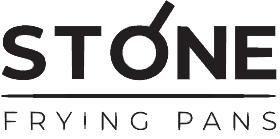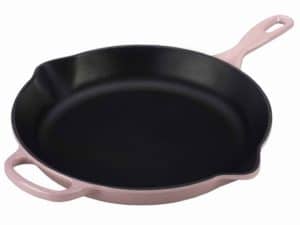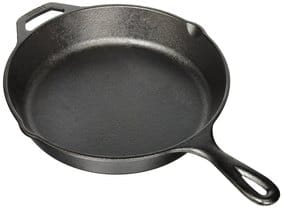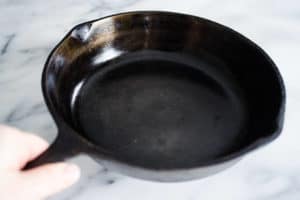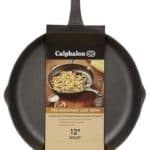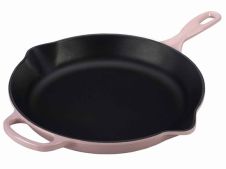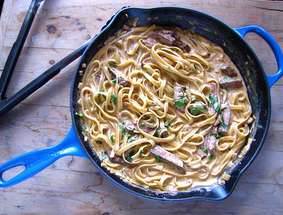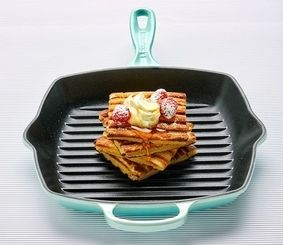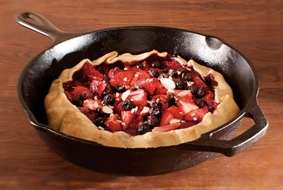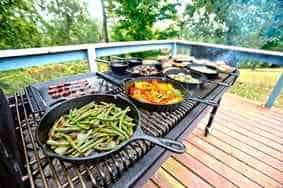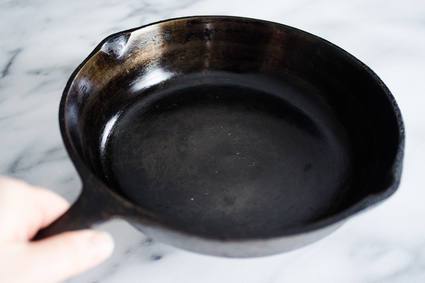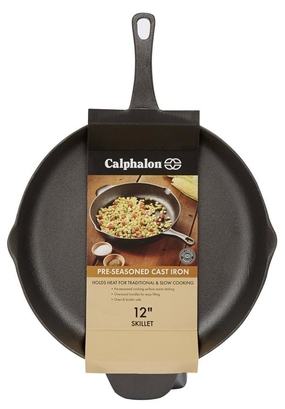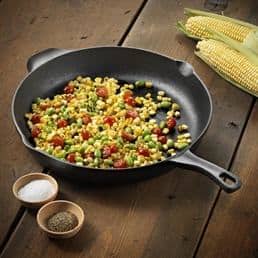The Best Cast Iron Skillets: The Definitive Guide
Cast-iron skillets have been used for decades to make the best fried chicken and caramelized onions. We've field tested 17 cast iron skillets to see which cast iron skillets are versatile and durable, and will last you a lifetime.
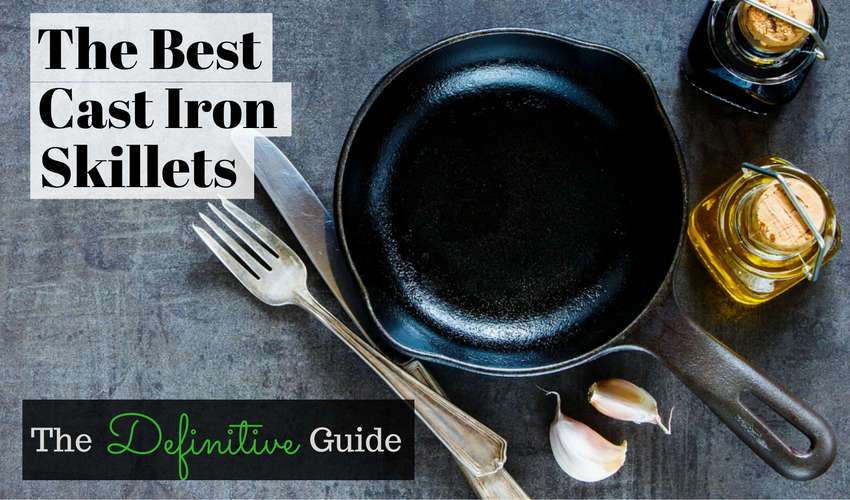
It’s been true for hundreds, if not thousands of years, and the fact still remains, a cast iron skillet is hands down one of the most useful bits of cooking kit you can have in your kitchen.
For those of you that are unsure of the benefits of cast iron, or just want to know how and when to use them, take a look at the information we’ve provided after the review section, to teach you all about cast iron cooking.
If you are already convinced that a cast iron skillet is the next cookware choice for you, then have a look at our detailed reviews below for each of the skillets in the table.
Our Top Picks at a Glance
Name | Power | Price | |
|---|---|---|---|
BEST PERFORMANCE |
| ||
BEST ALL ROUND |
| ||
BEST QUALITY |
| ||
BEST MATTE ENAMEL COATING |
| ||
BEST TRADITIONAL CAST IRON |
|
Who is this for?
Cast iron skillets are often used in cooking because they are known for being durable and long-lasting. They are also relatively easy to clean and are perfect for frying a variety of foods. Furthermore, cast iron skillets have been in use for centuries, with cookware dating back to around the 1800s.
Therefore, many home or professional cooks use cast iron skillets for cooking. Due to the heavier weight of the cast iron, college students, house wives, and generally younger people use these skillets.
Cast iron skillets are a great tool to use in any kitchen, and are often sought after as cooking and frying pans because of their versatility and durability.
The Criteria: How We Picked Great Cast Iron Skillets
Picking a Cast Iron Skillet Selecting a good quality cast iron skillet for your kitchen can be a difficult task. These skillets can range in size, weight, and thickness.
The following are some considerations we used to to help you select the perfect skillet.
- Size: A skillet should be large enough to cook one or more portions of food at a time, but not so big that it will take up too much space in your kitchen.
- Weight: A heavy skillet will heat more evenly and will be easier to cook with, but it may take up too much space on your stove. A cast iron skillet should be light enough to hold with one hand but heavy enough so it doesn't wobble on the stove.
- Thickness: A thinner skillet is more likely to warp, but it can also be used on a range
- Handles: Many cast iron pans have handles made of one piece with the pan, which is preferable to two thinner pieces that are riveted together.
Picking a cast iron skillet is a process that requires some thought and consideration. Cast iron skillets are very versatile and durable pieces of cookware. And you usually won't buy a new one for a very long time.
Testing The Skillets
Once we identified the criteria to pick a great cast iron skillet, we set off to test the cast iron skillets. We conducted the following tests on 17 different skillets:
- Egg Frying Test - We broke two eggs onto the skillet and tested the nonstick surface. Right out of the box, most of these skillets failed this test which was expected, since most of them were not seasoned. However, the le Creuset was more nonstick than most of the other pans. However, most of these pans improved with more seasoning.
- Steak Searing Test - We cranked up the heat and placed thick slabs of rib eyes onto the hot skillets. Most of the skillets were able to sear the steaks within 1 minute on each side. However, the sear was more noticeable on the Lodge pan partially because it was able to get hotter faster due to the design of the skillet.
- Baking Test- We wanted to see how nonstick each pan was. We set out to bake the cornbread and not surprisingly they didn't stick to the skillets. This was of course after 2 rounds of seasoning for each skillet.
- Handles Test - We held each pan upright and tried flipping it over to the backside. We repeated this process 5 times for each pan. We wanted to note in particular how the pan felt after flipping it 5 times, how heavy the pan was, and how the handle felt grip-wise. Our favorites were still the Le Creuset and the Staub cast iron skillets.
Cast Iron Skillets Cooking can sometimes be tricky if you don't know what you're looking for. Based on our testing, we've selected the below cast iron skillets to be the best of the 17 we tested.
Best Cooking Performance Cast Iron Skillet – Le Creuset Signature Skillet
Available Sizes: 11.75 inch | Weight: 6.8lbs | Pre-seasoned: Yes | Lid included: No | Add-on Options: cookware cleaner, cool tool, handle, nylon brush | Colors: Caribbean, Cerise, Flame, Merseille, Meringue, White
What We Like
What We Don't Like
This deep-sided pan with a very useful helper handle (these things are heavy, it really does help), is unmistakably part of the well-established and feted Le Creuset brand. The colors are absolutely amazing and stand out.
Key Benefits and Features:
- Handcrafted and with a lifetime guarantee - Le Creuset’s ambitious price point is the only downside with a skillet pan of this quality. But to be fair, it’s not just a name that you’re paying for. In the traditional manner, each piece in the Le Creuset cast iron range is individually cast and then the mold broken, so that each item is unique.
- Double Coat – A team of specialist craftsmen then fettle each piece, cleaning and smoothing the surface before the skillet is enameled twice and air dried.
- Robust High-Temperature Handling – It’s a long process, but one that results in an incredibly hardwearing pan that will cook beautifully. It will go from cooktop to oven with no problem, and the Le Creuset Signature Skillet is capable of handling high temperatures that might compromise some lesser pans.
- Goodbye Seasoning! – The enameled finish means that no seasoning is required (the pan that is, not the food you cook in it!), and this skillet will take pretty much anything in it’s brightly enameled stride. Only repeatedly letting the pan sit empty over a heat source can affect that artisan enameling, so don’t let the skillet boil dry!
While the initial outlay might make you recoil, you won’t ever need to buy another skillet. Many people hand on well-loved Le Creuset to their children, which is testament to the brand’s desirability and performance.
READ FULL REVIEW: Le Creuset Signature Skillet Review
RELATED: How To Use Cast Iron On Glass | The Best Grill Pans
Best All-Round Family Skillet - Lodge 10.25 inch Cast Iron Skillet
Available Sizes: 3.5", 6.5", 8", 9", 10", 10.25", 12", 13.25", 15" | Weight: 5lbs | Pre-seasoned: Yes | Lid included: Optional | Add-on Options: Handle holder, Rosie and Boy Scouts design | Colors: Black
What We Like
What We Don't Like
Lodge are another heavyweight brand in every sense of the word. They have an impressive range of cookware, but when it comes to seasoned cast iron, they really deliver.
Lodge standard sided skillets come in a few different sizes, from an omelette-for-one 6.5 inches to a hefty family-sized 17 inches. This 15 inch one is large, but not unwieldy.
Key Features and Benefits:
- Helper Handle – The helper handle is everything on a cast iron pan, and the slightly short but perfectly serviceable integral handle actually makes maneuvering a pan of this weight much easier.
- Beautiful Finish – Looks-wise, it’s great. It has a rustic authenticity about it that will always win new fans.
- Pre-seasoned and Enamelling – The fact that it’s seasoned and ready to cook will appeal to many, and the lack of expensive enameling means that you really wouldn’t mind sticking it over a campfire.
The Lodge Cast Iron 15 Inch Skillet is a sturdy, reliable all-rounder and you’ll probably find that it’s in use so much that you don’t need to find cupboard space for it.
Price-wise, there’s probably a cast iron pan in the Lodge range to suit most pockets. Even their enameled products are pretty competitively priced, and are a shoo-in for anyone who wants a Le Creuset skillet but balks at the price of the French brand.
RELATED: The Best Cookware Brands
Best Quality Cast Iron Skillet - Utopia Kitchen Cast Iron Skillet
Available Sizes: 12.5" | Weight: 8lbs | Pre-seasoned: Yes | Lid included: No | Add-on Options: None | Colors: Black
What We Like
What We Don't Like
There’s lots to like about this pre-seasoned pan, and not least the price. It’s very competitive for a skillet that performs consistently well and garners pretty enthusiastic reviews.
A key benefit is that it is sturdy, rustically attractive product in terms of it’s looks, it nevertheless has those all important features of a large (and prettily butterfly stamped) helper handle and double spout.
The Utopia Kitchen Cast Iron 12.5 Inch Skillet can handle baked egg tortillas, steaks, chops; whatever you care to throw at it. And because it hasn’t cost you the down payment on a car, you might actually be able to relax as it cooks up a campfire dinner. If you’re new to cast iron cookware and want an entry level pan that will do a great job. The Utopia Kitchen cast iron skillet is a great choice.
We recommend reseasoning again after you receive your cast iron skillet. This will ensure the skillet stays nonstick.
RELATED: How To Season A Cast Iron
Best Matte Enamel Coating - Staub Cast Iron 10-inch Skillet
Available Sizes: 10" inch | Weight: 6.58lbs | Pre-seasoned: Yes | Lid included: No | Add-on Options: None | Colors available: Graphite Gray, Cherry, Dark Blue, Grenadine, Matte BLack, Turquoise, White
What We Like
What We Don't Like
Staub cookware, along with Le Creuset, also began in France, and over the years the name has become synonymous with high quality and aesthetically pleasing cast iron cookware.
Key Features and Benefits:
- Lower Price – There are different price points for Staub products generally, and their cast iron range is undeniably at the top of most people’s pockets; but Staub can usually be found a little cheaper than Le Creuset. Additionally, there are sometimes pretty tempting deductions on their website, which means that you might get to snap up a bargain (something that’s arguably less likely with Le Creuset).
- Matte Enamel Coating – Like the rest of the cast iron range, the cast iron fry pan has a matte enamel coating. Where it seems to distinguish itself from it’s nearest competitors, is that many reviewers believe the non-stick quality of Staub cast iron becomes better over time.
- Look and Feel – In terms of how attractive they are, Staub products look as though they’ve just been on display in a pretty fancy restaurant in rural France. Indeed, that’s exactly where many of them are probably found! They look great, with a range of bright and more somber colors, and appealing, heritage styling.
This skillet is a smallish size, but probably ideal for a couple, small family or simply someone without too much storage space! The double pouring spout is a detail that you’ll appreciate every time you use it, and the sturdy helper handle is again, an essential feature with cast iron skillets.
RELATED: Cast Iron Dutch Ovens
Best Traditional Cast Iron Skillet - Calphalon Pre-seasoned 12-inch Skillet
Available Sizes: 12" inch | Weight: 6.8lbs | Pre-seasoned: Yes | Lid included: No | Add-on Options: None | Colors available: Black
What We Like
What We Don't Like
Finally, and firmly at the ‘reasonable’ end of the financial bracket, is the Calphalon Pre-Seasoned 12″ Skillet.
Key Features and Benefits:
- Well Rounded – A great all-rounder, we have lots of good things to say about our final contender for a spot in the top five.
- Functional Appeal – Traditional old-country charm and a very functional appeal means that most first-time cast iron skillet users will be pleased with their purchase.
- Sturdy Handle – Benefiting from a sturdy integral handle and that all-important second grip, this 12-inch pan is ideal for a smaller family.
What’s clear is that whatever your budget, this is a cast iron pan for you. Once you’ve chosen your skillet, let’s take a look at a couple of basic pointers when it comes to taking care of it.
Frequently Asked Questions (FAQ)
The New Cast Iron Age of Cooking! What is a Cast Iron Skillet?
Cast iron means that it’s made from molten metals – usually a combination of varying quantities of pig iron, recycled scrap iron and steel, limestone and carbon.
The molten metal is poured into molds (often made out of sand), and frequently in one piece, with the handle an integral part of the pan, so that it can be placed into a hot oven or over a fire.
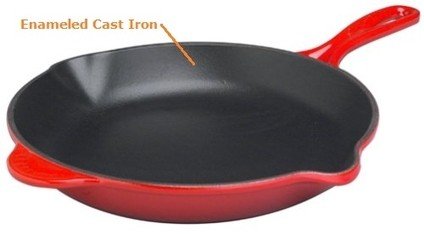
But where do you start when choosing a pan? What does ‘pre-seasoned’ even mean? Is it a good thing? What difference does enameling make? Is cast iron hard to cook with?
The relatively new development of enameling cast iron cookware with a vitreous glaze means that seasoning the pan isn’t strictly necessary.
Additionally, cleaning is made easier and the vibrant enamel colors are usually very attractive. However, the downside of these benefits is the cost. Enameled cast iron is much more expensive than a plain cast iron skillet, sometimes prohibitively so.
New technology produces new advances in cookware but it’s still true that nothing conducts heat as reliably as cast iron.
Versatile and essential when it comes to either high heat searing or long slow cooking, cast iron has been in our kitchens ever since there were kitchens.
But there are advanced, light-weight, non-stick pans coming on to the market all the time.
With so many to choose from, why would you cook with cast iron? Let’s take a look and find out more about it’s enduring appeal.
Why Cook With Cast Iron?
It’s the obvious question, and a good one, since the answer covers a lot of bases.
First of all, durability.
Choose your cast iron pan well, as the chances are it will be with you for life. Even the cheaper, un-enamelled types (some would say especially that type) will potentially last a lifetime, and longer.
It all means that cast iron pans are incredibly hardwearing, almost impossible to break and with no attached handles to come loose. They’re also very heavy, which might be a consideration if you have compromised upper limb strength.
But what about all the ‘rules’ around oiling your cast iron pan each time you use it, and certainly for the first time. How complicated is it really?
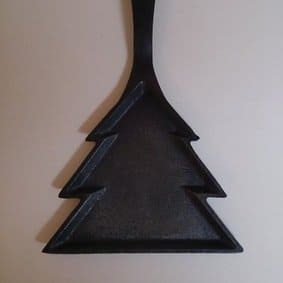
First Time or Seasoned Pro?
The first time you use your new cast iron skillet, even if it has been pre-seasoned, it’s worth doing it again. Building up those seasoned layers is key to an easy-to-use cooking surface.
Incidentally, you can’t harm the seasoned surface by scraping a cooking tool over it so no need to be too careful. The oil will actually bond with the metal itself over time and with correct seasoning can’t be easily ‘scraped off’ at all.
But aren’t you just trying to turn a cast iron pan into a non-stick one?
Why is a cast iron skillet fundamentally better when it comes to cooking food? Let’s take a look at why so many people swear by their cast iron pans, and eschew slick, non-stick ones.
These Pans Can Take Some Serious Heat! Why is a Cast Iron Skillet Better?
Many keen cooks find that once they cook with cast iron, it’s hard to go back.
Cast iron means that you can sear and cook at much higher temperatures than with regular pans.
You can make better pizzas than with a pizza stone, and any dish that requires you to switch between the hob and the oven will be a breeze.
For example, you want to make an authentic Italian ragu, so you sauté a sofrito of onions, garlic, celery and carrot; brown the meat and chicken livers, add herbs and a cup of wine to reduce down, and finally your crushed tomatoes or tomato paste.
Now ideally, the whole thing needs to sit in the oven for around 6 hours, blip-blipping away, while you get on with your day.
Oh, and then you can switch it back onto the hob again for the sauce to thicken up.
It’s really only a cast iron pan that can do all that. Ceramic dishes can’t be used over a direct heat sauce, and a regular pan might well not be oven safe.
Steaks, burgers, in fact most meat is fantastic seared in a cast iron pan. The process called the Maillard Reaction, which is the chef’s term for the chemical change that occurs when meat is browned and caramelized on a hot surface, is a revelation in a cast iron skillet, with a really deep, savory flavor.
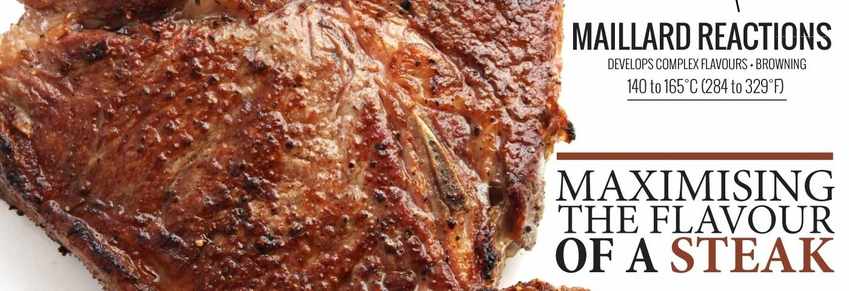
Okay, so we’re persuaded that cast iron can be versatile when it comes to switching between heat sources, but surely, despite all that, non-stick is so much easier. Life’s busy; if you can clean a pan without fuss, or just stick it into the dishwasher, surely that’s a no-brainer?
Well, we’re all for making cooking more relaxed and enjoyable, but non-stick doesn’t come without it’s own, erm…sticking points. Let’s take a closer look at that Teflon ‘no-brainer.’
Stick Around to Read This! Cast Iron Skillet or Non-Stick?
Despite all of the well-publicized benefits of cast iron, many people will still be attracted to a modern, lightweight, low cost, non-stick surface.
That’s fine, as long as you’re making an informed choice. There has been some controversy building around the ingestion of some of the chemicals used in the manufacture of non-stick pans.
The most widely known type of non-stick surface is Teflon. However, Teflon is not a substance, but a brand name for polytetrafluoroethylene (PTFE), which is classified as a manmade chemical.
Teflon is made using Perfluorooctanoic acid (PFOA), another manmade substance. Most people have low levels of PFOA in their bloodstream, but at a level that is not widely thought to cause harm.
For years, there have been concerns about people experiencing elevated levels of PFOA, thought to be from contaminated water or industrial exposure. The chemical stays present in the body for long periods of time, and although the long-term effects are not really known, there has been enough concern from the medical establishment for the World Health Organization, via the International Agency for Research on Cancer, to say that PFOA is “possibly carcinogenic to humans.”
At this point, it’s important to remember that almost all of the PFOA present in Teflon is burned off during the manufacturing process, and is not thought to occur in any significant amounts in the finished product.
Despite that, many people remain concerned over pans with non-stick surfaces, particularly because of the fear the act of heating up the Teflon surface will mean that harmful elements will be more easily available.
These fears are not groundless.
If a Teflon pan is overheated, for example, anyone breathing in the fumes may experience flu-like symptoms. This is a transient effect and apparently harmless in the long term, but something that most people would probably want to avoid.

But isn’t it true that cast iron isn’t quite guilt-free here either? Trace minerals can be transferred from the pan into the food that’s being cooked. Is that dangerous? It isn’t, but it’s something that definitely bears a closer look.
Cast Iron and Iron in Food. Getting Enough Iron?
By way of sharp contrast, not only does seasoned cast iron not have any harmful connotations in terms of chemical toxicity; it can actually help to support a healthy body by trace amounts of iron being transferred into your body by the food that you cook.
Is that good for us? By and large, yes it is.
We all need iron; it’s an essential mineral for our bodies. Children under the age of three however, are prone to iron toxicity (essentially too much iron), and so if you are concerned about it, then avoid cooking food for children under three in your cast iron skillet.
The age of the pan, the type of food you’re cooking and how long the food remains in contact with the pan are all relevant to how much iron is absorbed, but generally speaking, for most healthy people, it’s not a bad thing.
Steak Your Claim. Cooking With a Cast Iron Skillet.
Cooking with cast iron is about as far from new-fangled as you can get. Chefs across the world wouldn’t consider cooking with anything else. Our ancestors knew what they were doing when it came to a cast iron frying pan.
Fans say that one of the greatest things to cook in a cast iron skillet is a steak.
We concur.
Get your steak to room temperature, then oil and season the steak on both sides. Get your pan smoking hot, then cook the steak without moving or pressing it until it’s cooked to your liking. There are too many variables to suggest cooking times here (thickness of steak, how rare you like your meat), but what’s key is letting that wonderful caramelizing heat sear your steak to perfection.
You might be able to slip a pile of scrambled eggs out of a Teflon pan with one hand while stirring your morning coffee with the other, but really, Teflon can’t hold a candle to a cast iron skillet when it comes to flavor.
We want to help you understand exactly what to look for when investing in a new cast iron pan, and how to make the right choice for you.
We’ve taken a look at some of the very best cast iron skillets on the market and flagged up their selling points. Whether you’ve got $300 or less than $20 to spend; there’s a cast iron skillet to suit you. Take a look at our recommendations, starting with our top three picks, with something for every budget.
Cast Iron Clean Up! How Do I Clean a Cast Iron Skillet?
This is something that either attracts people to, or repels people from cast iron cookware.
First of all, they’re not something to stick in the dishwasher. A seasoned pan; that is one that has been treated with oil to give it ‘non stick’ surface; needs only a stiff brush and a little hot water to clean it.
It’s a bit of a myth that soap will destroy your skillet’s seasoning though; a little soap probably won’t harm a properly seasoned pan at all. Soaking the pan for a long time in detergent might well affect that seasoning though, so that’s what you need to avoid doing.
An enamelled cast iron pan will clean much more easily and some are allegedly dishwasher safe, but many people think that even enamelled pans can be compromised by washing in this way. Basically, most cast iron skillets, enamelled or not, can be cleaned with a bit of elbow grease and hot water. For any really stuck on bits, a paste of rock salt and water can help.
There are a few tips on how to season your pan once scrubbed; usually either coating the warm skillet with oil (flaxseed is often recommended) and then leaving to cool; or to rub shortening around the whole pan, and place into a hot oven, then turn the oven off and once again, allowing the skillet to completely cool before wiping out the excess oil.
So your skillet’s nice and clean, and you’ve seasoned it beautifully. So how do you store it? Are there any special tips to bear in mind?
Storage Solutions – How Do I Store My Cast Iron Skillet?
Once your pan is nicely seasoned, there’s not much that can harm it. Storing your pan with a dry tea towel inside is a common practice, just in case another pan gets stacked inside it, but to be honest, your skillet wouldn’t come to harm anyway.
The most likely way that a cast iron skillet would deteriorate is if it’s not used. Over time, an unused pan might get a few rust patches and become sticky. Chances are however, that once you start cooking with a cast iron skillet, you will put it to use pretty frequently, so you won’t need to worry too much about it deteriorating.
Many cast iron pots and pans in use today are a hundred years old or more, and are still as good as new. Collectors seek out pre-loved skillets for their incredible workmanship and functionality. Another way of looking at this is cast iron cookware lasts, so a little unintentional rough handling every now and then will go more or less unnoticed.
So, equipped with all the facts, you might now feel ready to take the plunge!
Time To Select Your Skillet! How To Buy a Cast Iron Skillet?
Check out our top five cast irons skillets and decide which one suits you and your budget the best. We’ve researched, tested and checked and we’re confident that any of these pans would make a terrific buy.
All in all, the Le Creuset Signature Skillet just sits as the very best-of-the-best, and you can always find the most competitive Le Creuset deals on Amazon.
Then have fun getting to know your new cast iron pan. After all, you’re going to be cooking together for a lifetime!
